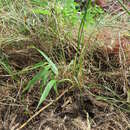Associations
provided by BioImages, the virtual fieldguide, UK
In Great Britain and/or Ireland:
Foodplant / parasite
hypophyllous telium of Puccinia longicornis parasitises live leaf of Arundinaria japonica
Description
provided by eFloras
Culms erect or nodding, 1–3(–5) m tall, to 1.5 cm thick; internodes long, finely ridged, finely mottled, with light ring of wax below each node; nodes slightly raised; sheath scar large. Branches usually 1 per node, without basal buds or branches on that branch, sometimes rebranching from distal branch nodes. Culm sheaths persistent, to 25 cm, basally glabrous, distally appressed hispid; auricles and oral setae absent; blade erect, 2–5 cm, abaxially glabrous. Leaf sheaths glabrous, margins membranous, not ciliate, auricles absent or small, erect; oral setae scarce, erect, or lacking; ligule oblique, long, slightly pubescent, eroded; abaxial ligule glabrous to finely ciliate;blade abaxially light green to glaucous, adaxially dark green, 15–37 × 1.5–5 cm, glabrous; pseudopetiole glabrous. Spikelets curving, narrowly terete, 3.5–10 cm; florets 5–20(–25). Lemma 1.2–1.5 cm, glabrous, often with fine mucro ca. 2 mm; palea nearly equal to lemma, glabrous, keels finely ciliate. Inflorescence not known.
- license
- cc-by-nc-sa-3.0
- copyright
- Missouri Botanical Garden, 4344 Shaw Boulevard, St. Louis, MO, 63110 USA
Synonym
provided by eFloras
Arundinaria japonica Siebold & Zuccarini ex Steudel, Syn. Pl. Glumac. 1: 334. 1854; A. usawae Hayata; Pleioblastus usawae (Hayata) Ohki; Pseudosasa usawae (Hayata) Makino & Nemoto; Yadakeya japonica (Siebold & Zuccarini ex Steudel) Makino.
- license
- cc-by-nc-sa-3.0
- copyright
- Missouri Botanical Garden, 4344 Shaw Boulevard, St. Louis, MO, 63110 USA
Physical Description
provided by USDA PLANTS text
Perennials, Terrestrial, not aquatic, Rhizomes present, Rhizome elongate, creeping, stems distant, Stems woody, Stems nodes swollen or brittle, Stems erect or ascending, Stems caespitose, tufted, or clustered, Stems terete, round in cross section, or polygonal, Stems branching above base or distally at nodes, Stem internodes hollow, Stems with inflorescence 2-6 m tall, Stems, culms, or scapes exceeding basal leaves, Leaves mostly cauline, Leaves conspicuously 2-ranked, distichous, Leaves pseudo-petiolate, petiole attached to sheath, Leaves sheathing at base, Leaf sheath mostly open, or loose, Leaf sheath smooth, glabrous, Leaf sheath hairy, hispid or prickly, Leaf sheath and blade differentiated, Leaves borne on branches, Leaf blades lanceolate, Leaves with distinct crossveins, net-like transverse veins, Leaf blades 1-2 cm wide, Leaf blades 2 or more cm wide, Leaf blades mo stly flat, Leaf blades mostly glabrous, Leaf blades more or less hairy, Ligule present, Ligule an unfringed eciliate membrane, Inflorescence terminal, Inflorescence an open panicle, openly paniculate, branches spreading, Inflorescence solitary, with 1 spike, fascicle, glomerule, head, or cluster per stem or culm, Inflorescence with 2-10 branches, Flowers bisexual, Spikelets pedicellate, Spikelets laterally compressed, Spikelet less than 3 mm wide, Spikelets with 2 florets, Spikelets with 3-7 florets, Spikelets with 8-40 florets, Spikelets solitary at rachis nodes, Spikelets all alike and fertille, Spikelets bisexual, Spikelets disarticulating above the glumes, glumes persistent, Spikelets disarticulating beneath or between the florets, Rachilla or pedicel glabrous, Glumes present, empty bracts, Glumes 2 clearly present, Glumes distinctly unequal, Glumes equal to or longer than adjacent lemma, Glumes 4-7 nerved, Glumes 8-15 nerved, Lemmas thin, chartaceous, hyaline, cartilagi nous, or membranous, Lemma 8-15 nerved, Lemma glabrous, Lemma apex acute or acuminate, Lemma awnless, Lemma mucronate, very shortly beaked or awned, less than 1-2 mm, Lemma margins thin, lying flat, Lemma straight, Palea present, well developed, Palea membranous, hyaline, Palea about equal to lemma, Palea 2 nerved or 2 keeled, Palea keels winged, scabrous, or ciliate, Stamens 3, Stamens 4 (2 2), Styles 3 or 3-fid, deeply 3-branched, Stigmas 3, Fruit - caryopsis, Caryopsis ellipsoid, longitudinally grooved, hilum long-linear.
Pseudosasa japonica: Brief Summary
provided by wikipedia EN
Pseudosasa japonica, the arrow bamboo or metake, is a species of flowering plant in the grass family Poaceae, native to Japan and Korea. This vigorous bamboo forms thickets up to 6 m (20 ft) tall with shiny leaves up to 25 cm (9.8 in) long. The culms are typically yellow-brown and it has palm-like leaves. The common name "arrow bamboo" results from the Japanese Samurai using its hard and stiff canes for their arrows. It grows up to 4 cm (1.6 in) a day.
- license
- cc-by-sa-3.0
- copyright
- Wikipedia authors and editors

